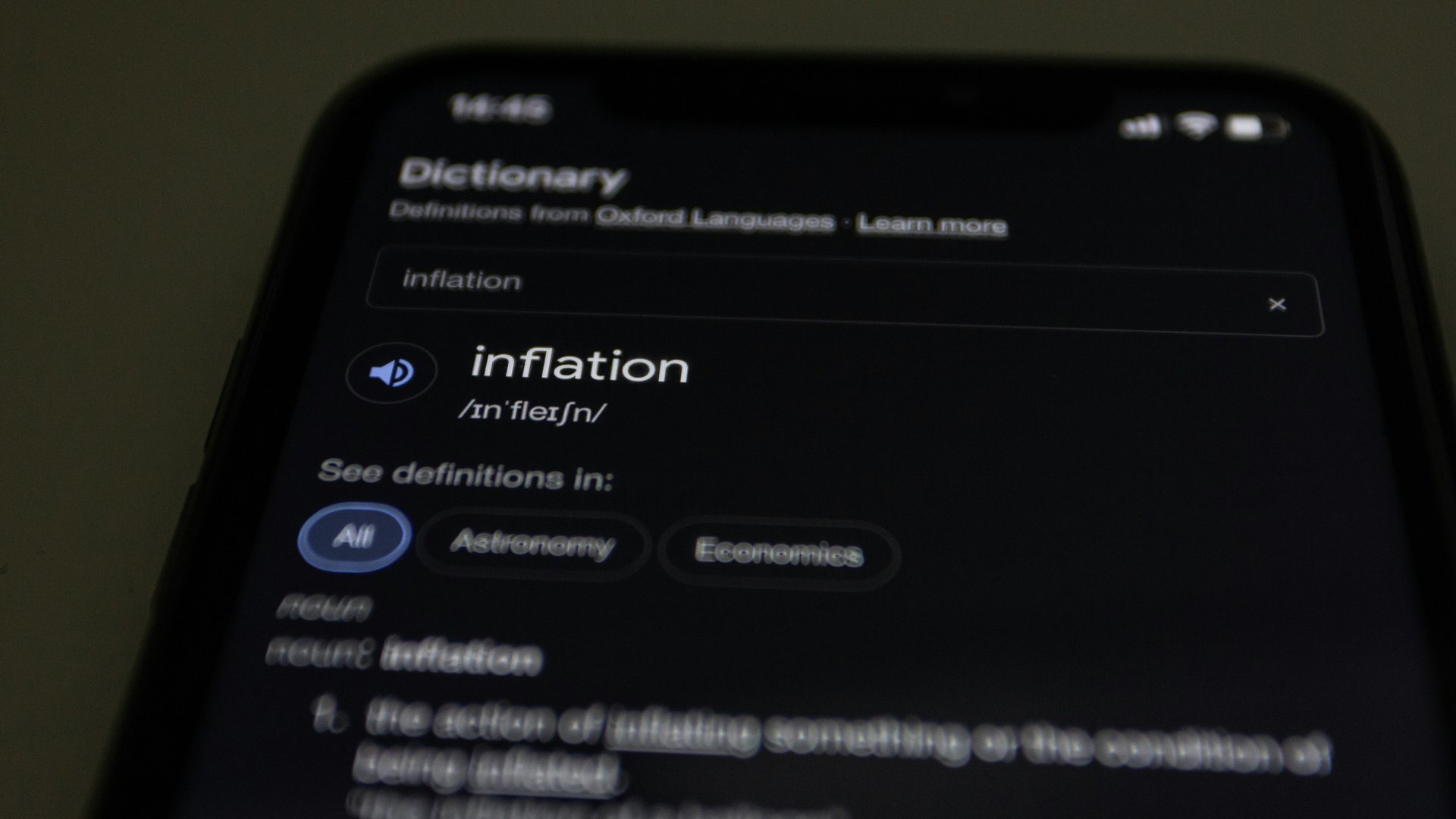What is inflation?
Learn what drives inflation and how it can impact prices, purchasing power, and the overall economy
Inflation is consistently in the news, especially when it contributes to rising grocery prices or other everyday costs. At its simplest, inflation is the rate at which prices increase over time.
Moderate inflation is common in healthy, growing economies. In these scenarios, wages tend to rise alongside prices, maintaining a balance in purchasing power (the amount of goods or services you can buy with your money).
However, when inflation accelerates, prices can outpace wages, meaning each dollar has less purchasing power, more noticeably than during periods of stable or slow inflation. Even a small increase in inflation can influence business pricing, consumer spending, and household budget management.
It’s also important to note that inflation doesn’t always show up as higher price tags. Sometimes companies respond to these rising costs by reducing the size or quantity of their products while maintaining the same prices — this is known as shrinkflation.
Even subtle changes can make it harder for consumers to immediately recognize the full impact of inflation on their budgets.
Measuring inflation
Economists measure inflation using tools like the Consumer Price Index (CPI) and the Producer Price Index (PPI), both published by the Bureau of Labor Statistics. Each offers a different perspective on how prices are changing.
Consumer Price Index (CPI)
The Consumer Price Index tracks the average change in the prices of a set group of goods and services, including food, rent, health care, and transportation.
The CPI, the most widely used measure of inflation, helps economists understand trends in the cost of living. When the CPI goes up, it means everyday expenses are rising for most households.
For example, if the CPI shows the cost of a grocery basket increasing by 3% year-over-year, consumers are generally paying 3% more for the same essential groceries than they did a year ago. What might have cost $100 to purchase last year costs $103 today.
Producer Price Index (PPI)
The Producer Price Index tracks the change in prices domestic sellers receive for goods and services over time. It focuses on the supply side of the economy, capturing costs before they reach the consumer. Changes in the PPI can signal future shifts in consumer prices.
For example, if the PPI indicates rising steel or lumber costs, economists might expect manufacturers to pass those increases on to customers by hiking prices on cars or new homes.
Causes of inflation
There are three main types of inflation, each driven by different forces:
- Demand-pull inflation occurs when demand outpaces supply. For example, if people want to buy more cars than automakers can produce, prices are likely to rise.
- Cost-push inflation happens when production costs increase and businesses pass those costs on to consumers to maintain profit margins. For example, a spike in oil prices can lead to higher transportation costs.
- Built-in inflation, or wage-price inflation, occurs when workers seek higher wages to keep up with the cost of living. Those higher wages increase the labor costs for businesses, so companies raise prices, creating higher costs for consumers.
The effects of inflation
Inflation doesn't affect everyone the same way. While some groups struggle with rising prices, others benefit from them, making consumer sentiment regarding inflation a complex topic.
Negative effects of inflation
The adverse effects of inflation include:
- Reduced purchasing power. If prices rise faster than wages, consumers experience reduced purchasing power.
- Hardships for people on fixed incomes. Retirees and others with fixed monthly payments may struggle to keep up with rising costs.
- Erosion of savings. When inflation rises faster than average savings rates, the value of money in low-interest accounts declines over time, reducing purchasing power; so even today, Americans may effectively lose money unless their savings are in high-yield accounts.
- Uncertainty and planning difficulty. Rapid inflation makes it harder for businesses and individuals to plan for the future, creating hesitation around spending and investing.
Positive effects of inflation
Inflation can also have positive effects, such as:
- Easier debt repayment. In cases where inflation increases wages, debt payments that remain fixed over time might be easier to repay. For example, if your mortgage payment is $1,100 and your wages increase, a lower percentage of your paycheck goes toward that monthly expense.
- Encourages spending and investment. If inflation is rising, people may buy items now rather than wait until they become more expensive. They may also seek out investment opportunities with return rates higher than the rate of inflation to protect their spending power in the future.
- Wage growth in some sectors. In tight labor markets, inflation is often paired with rising wages, especially in industries with high demand for workers.
- Support for economic growth. Moderate inflation — a steady, manageable increase in prices (likely around 2% annually) — can be a sign of a growing economy.
Controlling inflation
Inflation exists in every economy and would rise and fall without formal intervention. However, governments and central banks use tools such as monetary and fiscal policy to manage it.
Monetary policy
Central banks, such as the U.S. Federal Reserve, manage inflation by adjusting interest rates or the money supply. When inflation is too high, they often raise interest rates. This makes borrowing more expensive, slowing down spending and reducing price pressure.
They can also reduce the amount of money circulating in the economy, making it harder for prices to keep rising. However, if inflation is too low, central banks may lower rates or increase the money supply to encourage more spending and investment.
The policy of the Federal Reserve is to maintain an average 2% inflation rate over time.
Fiscal policy
Governments influence inflation through spending and tax laws. This is known as fiscal policy.
If inflation rises too fast, a government might scale back public spending or increase taxes. This decreases the amount of money in the economy, which might help lower demand. Lower demand can slow the economy and, in some cases, reduce inflation.
In contrast, when inflation is low, governments may increase spending on infrastructure or social programs or cut taxes. These measures can increase economic activity and raise inflation toward target levels.
Inflation vs deflation vs stagflation
Inflation isn't the only economic condition that impacts prices. Deflation and stagflation can also disrupt markets, slow growth, and challenge economic stability.
Deflation
Deflation occurs when prices fall across the economy over time. While that might sound good for consumers, it can signal deeper economic trouble.
When prices drop, it can hurt business profits and lead to layoffs. Layoffs decrease household budgets, which usually reduces spending. As prices drop, people may delay making purchases, hoping costs will sink even lower in the near future. This further reduces demand, leading to a cycle of shrinking business revenues, reduced spending, lower wages, and higher unemployment.
Stagflation
Stagflation occurs when high inflation and slow economic growth combine. In this situation, prices rise despite weakened business activity and job growth.
This creates a tough environment for consumers and policymakers. For example, if grocery prices are climbing but wages and job opportunities remain flat, households may find themselves paying more for essentials despite earning the same or less.
Stagflation is especially difficult to fix because the usual inflation-fighting tools, such as raising interest rates, can slow the economy even more. The U.S. last experienced stagflation during the 1970s and early 1980s, when high inflation, sluggish growth, and rising unemployment all coincided.
Economists have raised concerns in more recent years about a return to stagflation due to weakening job growth, persistent inflation, and new tariffs.

